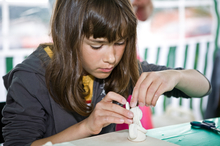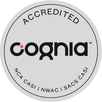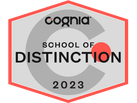IDEAVENTIONS ACADEMY
 For purposes of this post, when I refer to Art, I am referring to the Fine Arts and Digital Arts. Music and Drama, which are also arts, are covered separately. A few years ago I had the pleasure of meeting a very accomplished artist, Alessandra Ricci. It all started because I wanted to give a gift that blended science and art, and Alessandra created this magnificent work of art using a portrait of John Snow (the epidemiologist, not the actor) on a scarf. It had been many years, but seeing what she was able to create, brought back memories from high school and spending time at the National Gallery of Art admiring the work of Thomas Cole and Albert Bierstadt after my internship at the Air and Space Museum. Going into this year and planning the school, when we discussed Art, it evoked feelings of wonder and peace. Art, however, is not traditionally a required course in Middle School. Therefore, the first question we asked ourselves was, “Should it be an elective or should it be part of the core curriculum?” The next question we asked ourselves was, “What are our learning goals for our students related to art?” To answer the first question, we had to answer the second question. Our goal for art is very similar to our goals for science: to expose students to this wonderful world of beauty and expression so that kids become aware of what is out there as they find an area (or areas) that appeals to them. We also want to teach students the skills that they can take into their work in the future, from understanding perspective to improving their drawing, we believe that these skills are required and not an elective. With this goal in mind, we envisioned an art program that “sampled” different media and techniques. For one-third of the year, students would learn about 2D art (e.g., watercolors, pastels, drawing, caricatures, etc.), one-third of the year, they would do 3D art (e.g., sculpting, pottery, mosaics, etc.) and the last third would be digital arts (e.g., photography, 3D design, etc.). That was the idea…. Then came the implementation… We quickly learned that the art world is very similar to the scientific community, everybody is very specialized. We had found great people that worked with mosaics or great people that worked in oils or great people that worked in pastels, but we couldn’t find someone that would cover everything we were looking for. It was easy to understand since at Ideaventions, we live the same scenario as it relates to science and engineering. An aerospace engineer is usually not comfortable teaching a biology class and vice versa, a microbiologist is usually unable to teach a computer science class. We considered bringing in experts for 9-week units, but that did not provide the continuity that we were looking for throughout the year and in subsequent years. We then decided to look for an “Ideaventions” for the arts, a company that would be able to work with us to teach a variety of art techniques and used different media and provide the overall framework for art education. We found The Art Station, based out of Leesburg, and loved their program. The more I learned about their philosophy and their programs, the more excited I was about bringing the Art Station to Ideaventions Academy. I had to make a 20° turn since the media and techniques are integrated into their various classes, but their curricula, all developed by artists and educators, presents the material in a much more engaging way than we could have imagined. Working as a team with The Art Station, we worked with their curriculum and defined a sequence that would provide our students the art education that we were looking for, while incorporating language arts and life skills into the program. Each week, students will not only learn about a medium, a technique or an artist, but they will also have Show-and-Share time, where they will practice oral communications by presenting their work, as well as learning how to provide and how to receive constructive feedback in an environment built on trust. Finally, students will be given the opportunity to display their work and through this process they will learn to appreciate the work of museum professionals as the link between the work of art (or object) and their audience (or the viewing public). The breadth and depth of the curriculum that The Art Station is able to bring to our school is exciting, and we think the best way to describe it is by presenting this coming year’s scope and sequence: We start the year by Exploring Mixed Media. This exposure unit introduces students to a wide range of mediums including collage, clay, up-cycled materials, acrylic paint, colored pencils, construction paper, and chalk pastels. The second unit, In the Footsteps of the Masters, tackles Art History in a hands-on creative way. Students learn about both traditional and contemporary artists, exploring each artist’s iconic piece, and then are encouraged to create their own unique works of art by applying the same technique or style. The third unit of study introduces a variety of Unique Techniques, such as the batik method, photo transfers, printmaking. The emphasis is on process and material selection—teaching students the importance of sequencing and providing them with hands-on experience that tests the properties of each medium. Lastly, we end the year by diving deep on a contemporary art forms, Graphic Novels. We love how comics help us integrate art with storytelling. From designing characters to developing story arcs, this holistic approach allows students to flourish in many ways: They’ll learn the importance of structure, the aesthetics of design and the freedom of imagination. By the end of the session, students will have a full comic strip built upon the principles learned over the course of the program. I am so excited about the strength of the Art program at Ideaventions Academy and that we were able to find a partner that shares our philosophy and is able to make our goals a reality. P.S. I have deliberately not discussed creativity as part of the art program. This is because I strongly believe that creativity permeates through the different STEM fields, the arts and the humanities. Creativity deserves its own post and will be covered later this summer.
0 Comments
Your comment will be posted after it is approved.
Leave a Reply. |
AuthorJuliana Heitz is co-founder of Ideaventions Academy and is very excited to share the thinking behind the Academy. Archives
October 2023
Categories |
Copyright © 2010-2024| 12340 Pinecrest Road, Reston, Virginia 20191 | 703-860-0211 | [email protected] | Tax ID 27-2420631 | CEEB Code 470033
 RSS Feed
RSS Feed




